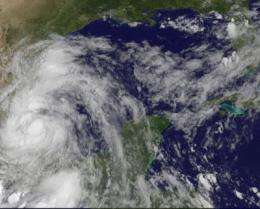Tropical Storm Arlene moves inland over Mexico: A GOES-13 satellite movie view

Tropical Storm Arlene made landfall early today and is making its way through northeastern Mexico today as the GOES-13 satellite continues to track its movement. A movie from today's GOES satellite data shows Arlene making that landfall and moving inland.
Tropical Storm Arlene never made to hurricane strength, but did become a strong tropical storm with maximum sustained winds near 65 mph. To be classified hurricane strength maximum winds need to be 74 mph or greater. As a strong tropical storm, Arlene is creating a lot of problems with very heavy rainfall causing flash flooding and mudslides in mountainous areas. Arlene is dropping between 4 and 8 inches of rain as it tracks through northern Mexico with isolated amounts up to 15 inches falling in mountainous areas.
Arlene made landfall near Cabo Rojo in northeastern Mexico this morning, June 30 at 7 a.m. EDT. It continues to move west through northern Mexico. By 11 a.m. EDT, Arlene's center was just west of Cabo Rojo as it tracks slowly to the west at 7 mph (11 kmh). It was centered near 21.6 North and 97.7 West. That's about 45 miles north-northwest of Tuxpan and the same distance from Tampico, although south-southeast of that city. Minimum central pressure is 994 millibars.
GOES-13 is one of several satellites keeping track of Tropical Storm Arlene. Because GOES-13 monitors the eastern U.S. and the Atlantic, and Arlene is moving west, the GOES-11 satellite is going to pick up watching Arlene's movements. GOES-11 monitors the western U.S. and the eastern Pacific Ocean.
Both GOES-13 and GOES-11 are operated by NOAA. NASA's GOES Project creates images and animations from both satellites, and used the continuous data from GOES-13 to make a two-day movie showing Arlene's landfall today. NASA's GOES Project works out of the NASA Goddard Space Flight Center in Greenbelt, Md.
The animation shows Arlene from June 28 at 1415 (10:15 a.m. EDT) to June 30 at 1415. In those two days, the circulation of Arlene became more apparent as the center moved away from the Yucatan Peninsula and into the southwestern Gulf of Mexico. Satellite imagery also showed that eastern side of the storm contained more cloud cover when it was over open ocean.
The National Hurricane Center noted that the center of Arlene should continue moving inland over mainland Mexico today and will likely dissipate over the central Mexico mountains sometime on Friday, July 1.
Provided by NASA's Goddard Space Flight Center





















